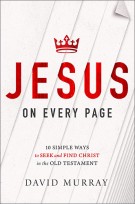Jesus himself told us that he is the grand subject — the hero, if you will — of the Old Testament Scriptures, and it is the delight of every Christian who takes the time to investigate to see just how it is so. The title of this book — Jesus On Every Page — announces a theme that is immediately attractive to every believer.
David Murray, an experienced pastor also, is professor of Old Testament and Practical Theology at Puritan Reformed Theological Seminary, and this book reflects his interests on both levels. Yet as the subtitle suggests — Ten Simple Ways to Seek and Fine Christ in the Old Testament — he is not addressing the scholar but the student who wishes simply to learn how, in fact, Jesus is foreshadowed in the Old Testament Scriptures.
Overview
In Part 1 Murray tells his own story (as he does somewhat through the entire book), tracing the development of his own understanding of the Old Testament as a book about Jesus. He surveys the various approaches to the subject that have been offered by differing schools of thought, and he highlights the claims of Jesus and the apostles regarding, affirming their conviction that the Old Testament. Here Murray focuses attention on the implications of such passage as 1 Peter 1:10-12; Gal.3-4; 2 Corinthians 3:6-18; John 1:17; 5:39, 46; and 8:56, looking back to Old Testament figures such as Abraham and Moses and developing a hermeneutical framework for his study. This entire section (chapters 1-6) is rather autobiographical with regard to the evolution of Murray’s own thinking, but it is a biblical and theological investigation also, weighing interpretations and offering observations of some of the leading biblical passages that speak to the point of Christ in the Old Testament.
The primary contribution of the book is found in Part 2 (chapters 7-16), where Murray traces out the various ways in which Christ is presented in the Old Testament. Not all is predictive prophecy. Christ is anticipated in certain aspects of the creation narrative also, in the life experiences, successes, and failures of various Bible characters, the angel of the Lord and other divine appearances, the moral law, the patterns of Israel’s history, pictures and “types” (symbols), promise and hope, and in wisdom and poets. In each category Murray provides helpful samples to illustrate his point that Christ is, in fact, to be found in the Old Testament in a variety of ways.
Strengths
Two leading accomplishments in Murray’s book stand out. First, and most importantly, he demonstrates successfully that there are varieties of biblical ways that Christ is presented and anticipated in the Old Testament. The ten chapters are of course not exhaustive of each point but well substantive enough to illustrate his point and provide many suggestive patterns of Old Testament Christological design. Along the way he cautions against popular but misguided approaches also, and with the positive illustrations of his more responsible approach he both establishes his point and exposes the error of often popular but misguided approaches.
Second, Murray’s categories of approach provide concrete, reliable guidance for the Bible student and for the teacher / preacher who wants to handle Scripture responsibly in a Christ-centered way. His approach is simple, his lines of thought are easy to follow, and his categories provide a simple and helpful structure for reading the Old Testament. In brief, the book is practical, eminently accessible, and genuinely helpful. As such, the book is useful for “teacher training” and distribution in the local church. A Study Guide is provided in the back of the book to help along these lines also.
One Weakness?
Christ-centered interpretation of Scripture, thankfully, is a growing area of interest and study, and many books have been offered to our generation to help us get the point. More than most, Murray’s book is marked by the presuppositions of a rather traditional covenant theology, and his discussions of hermeneutics, the law of Moses, and the covenants are not shaped particularly by the Biblical-Theological categories and trajectories that we have seen established especially in recent years. And so not all will find his arguments here convincing, and some churches will hesitate recommending this book for their teachers. But in fairness it should be pointed out that more often than not these more foundational questions do not have shaping influence on the substance of Murray’s broad categories of approach — that is, his suggested “Ten Ways” of approach do not usually depend on these covenantal presuppositions. And even given these considerations Murray offers much that all sides will find very useful.
Happy Endorsement
Here is the endorsement I gave the book as it was published.
There could scarcely be a more worthy pursuit than seeking to learn of Jesus in the pages of Scripture. And — even allowing for the many differences in approach and interpretation — it would be difficult indeed to find a more accessible, concise, practically helpful, warm-hearted guide than David Murray’s Jesus On Every Page.
Fred G. Zaspel is a pastor at Reformed Baptist Church in Franconia, PA, and professor of theology at Calvary Baptist Seminary. He is also the executive editor here at Books At a Glance.
